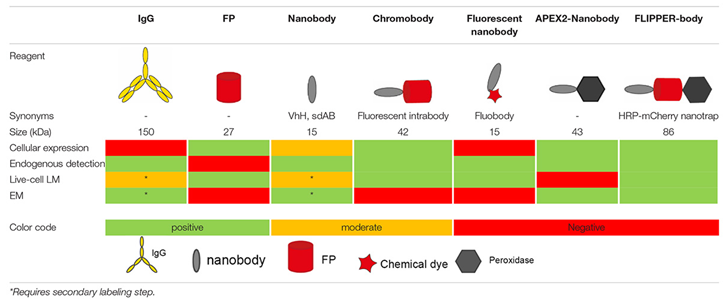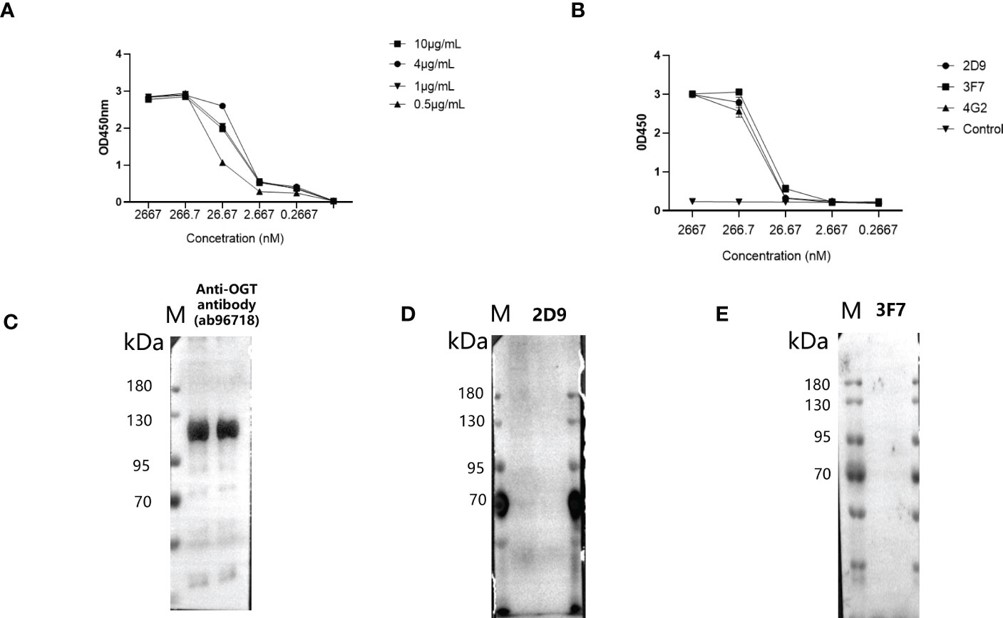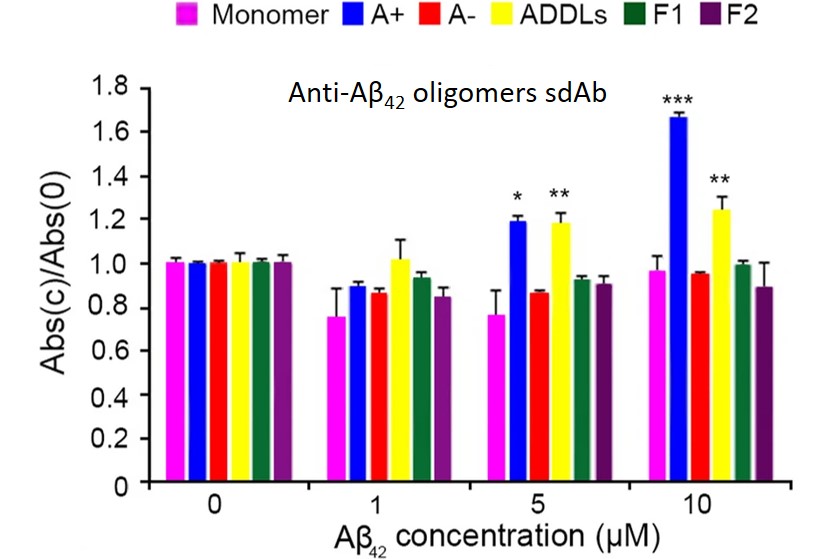With the advent of new antibody engineering technologies, conventional antibodies have been minimized into smaller antibody formats. Endowed by continuously improved technical methods, single domain antibodies (sdAbs) have become proficient tools in diagnostics due to their unique biochemical, biophysical, and pharmacological characteristics. Creative Biolabs has engaged in the in vitro and in vivo diagnostic field for many years and accumulated rich experience in the development of diagnostic tools for academic use. We now provide customized sdAb-based detection tool development services for global clients.
SdAbs as Sensitive Detection Probes
Detection probes should ideally meet most of the following characteristics: high probe accessibility, stability and selectivity towards the target, even in complex samples, and cost-effective large-scale production. On the one hand, probe accessibility is determined by probe size. When small antibody fragments such as sdAbs are coated on adsorptive plates, the vicinity of the adsorbing surface might hinder the antigen-probe interaction. On the other hand, probe accessibility is also dependent on a uniform, directional probe orientation. Promisingly, many approaches have been proposed to address these problems. For instance, the accessibility of coated sdAbs in ELISA can be improved by C-terminal peptide extension such as provided by a myc/His-tag or by fusion to Fc chain.
 Fig.1 Overview of different probes used in microscopy.1,4
Fig.1 Overview of different probes used in microscopy.1,4
Due to the intrinsic stability and smaller size, sdAbs exhibit a better denaturation resistance during harsh probe regeneration, and a higher probe density that mediates an enhanced detection sensitivity in surface plasmon resonance (SPR)-based detection systems. SdAbs have also been evaluated as capturing ligands in antibody-based slide and bead arrays. For instance, small amounts of bacterial lysates containing in vivo biotinylated sdAbs have been applied to streptavidin beads and used for sensitive biomarker detection in patient sera.
SdAb for Pathogen Diagnosis
For pathogen diagnosis, many sdAbs have been developed in case the performance of available monoclonal antibodies (mAbs) is unsatisfactory. For instance, sdAb has been used successfully to distinguish between Brucella and Yersinia infections in livestock but traditional mAbs have failed. Similarly, species-specific sdAbs for the detection of Taenia solium infection in pigs complement the existing genus-specific mAbs.
In a previous study, a sdAb-based agglutination reagent has been evaluated for HIV diagnosis. The reagent comprises the fusion between an HIV antigen (HIV-1 p24) and a red blood cell-specific sdAb. The presence of anti-p24 antibodies in HIV-positive serum then mediates agglutination upon the addition of the p24-sdAb fusion proteins. Based on this approach, diagnosing a variety of diseases could be possible when disease-specific antigens are available.
What Can We Do for You?
To maximize the potential of sdAbs, Creative Biolabs has established methods to fuse them with highly sensitive enzymatic or antigenic reporters. These Nano-reporters (fusions of reporter and sdAb) can be readily produced in cultured cells, purified in a single step, used to label cells or tissue, and stored indefinitely in the form of DNA or DNA sequences. In theory, nano-reporters contain the following six elements:
- An N-terminal mammalian signal peptide
- A HA epitope tag to enable immunochemical detection of the protein independent of its binding and enzymatic activities
- A sdAb
- Spacer
- Reporter such as HRP
- A His epitope tag to enable one-step affinity purification of the protein
Services
- Species-specific sdAb generation
- Genus-specific sdAb generation
- sdAb-reporter fusions development
- Customized products are suitable for different diagnosis platform such as electrochemical immunoassay
- Customized Labeled Nano-tracer as Imaging Tools
- Customized Targeted Nano-tracer Development
Given the rapidly increasing rate of sdAb generation, our Nano-reporter platform provides a versatile and scalable platform for immunohistochemical and biochemical analyses. If you are interested in our services, please directly contact us for more information.
Published Data
1. A Shark-Derived Single-Domain Antibody for OGT Detection and Intracellular Localization
 Fig.2 Evaluation of specificity and reactivity of the biotinylated anti-OGT sdAbs.2,4
Fig.2 Evaluation of specificity and reactivity of the biotinylated anti-OGT sdAbs.2,4
In this study, researchers developed shark variable domain sdAbs targeting O-GlcNAc transferase (OGT) by immunizing sharks, constructing a phage display library, and performing panning. The affinity of the sdAbs for OGT was assessed using ELISA and BIACORE, with three high-affinity sdAbs identified. Surface plasmon resonance (SPR) analysis revealed KD values of 35.5 nM, 53.4 nM, and 89.7 nM for the three sdAbs. These sdAbs were biotinylated and applied in various assays, including ELISA, flow cytometry, and immunofluorescence, to detect and localize OGT. The EC50 values for these sdAbs were 102.1 nM, 40.75 nM, and 120.7 nM, respectively. Structural predictions indicated that one sdAb binds to OGT at the Ser375, Phe377, Cys379, and Tyr380 residues. These results demonstrate that shark-derived anti-OGT sdAbs are valuable tools for in vitro detection and intracellular co-localization of OGT, aiding research on O-GlcNAcylation.
2. A Single-Domain Antibody for Detection of Toxic Aβ42 Oligomers in the Alzheimer’s Disease CSF
 Fig.3 ELISA measurements using sdAb for synthetic Aβ42 detection in vitro.3
Fig.3 ELISA measurements using sdAb for synthetic Aβ42 detection in vitro.3
In this study, researchers designed a sdAb targeting Aβ42 oligomers to detect these species in vitro and in cultured cells selectively. Using dot-blot, ELISA, and STED microscopy, they showed that the sdAb preferentially identified Aβ42 oligomers over monomers and fibrils. Compared to commercially available conformation-sensitive antibodies, this sdAb also significantly inhibited oligomer binding to neuronal membranes, restoring mitochondrial function. The researchers applied the sdAb to cerebrospinal fluid (CSF) samples from Alzheimer's disease (AD) patients, revealing well-resolved Aβ42 oligomers in the CSF of AD patients, which were not present in healthy individuals. These findings suggest that sdAbs targeting soluble toxic species like Aβ42 oligomers could be a promising tool for early AD diagnosis.
References
- De Beer, Marit A., and Ben NG Giepmans. "Nanobody-based probes for subcellular protein identification and visualization." Frontiers in cellular neuroscience 14 (2020): 573278.
- Xi, Xiaozhi, et al. "A novel shark single-domain antibody targeting OGT as a tool for detection and intracellular localization." Frontiers in Immunology 14 (2023): 1062656.
- Bigi, Alessandra, et al. "A single-domain antibody detects and neutralises toxic Aβ42 oligomers in the Alzheimer’s disease CSF." Alzheimer's Research & Therapy 16.1 (2024): 13. Distributed under Open Access license CC BY 4.0. The image was modified by extracting and using only part of the original image.
- Distributed under Open Access license CC BY 4.0, without modification.
For Research Use Only.

